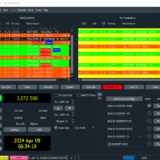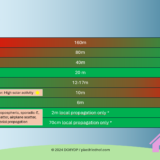Nikon Z6 II with Nikkor Z 24-70mm 2.8 – The ultimate video dream team
A focal length of 24-70mm is ideal for video recording. Reason enough to take a closer look at the Nikon Nikkor Z 24-70mm 2.8. A review of the autofocus, image stabilization and focus noise when used on the Nikon Z6 II.
I have only recently switched to the Nikon Z system. My Nikon Z6 II (Amazon Affiliate Link) is also my first full-frame camera and in just 3 weeks I have already learned to love the entire system. A big contribution to this new love was made by the Nikon Z 24-70 2.8 (Amazon Affiliate Link). Here’s why.
For video, I’ve been using my Nikon D500 or D7500 with either the Sigma 18-35mm 1.8 Art (Amazon Affiliate Link) or, in most cases, the Sigma 24-70mm 2.8 Art (Amazon Affiliate Link).
The focal length of 24-70mm provides sufficient flexibility for shooting landscapes, portraits or reportage. With a shallow depth of field due to the 2.8 aperture, you can set the scene in a variety of ways. At 35mm focal length, the image field looks particularly natural due to its similarity to the perception of the human eye.
Autofocus – super smooth and super quiet
Unlike the D500 and the D7500, the Nikon Z6 II has a permanent video autofocus that really deserves it’s name. Unlike AF-C, this continuously tracks focus, not just when focusing is activated. AF-F alone is cool, but it only plays to its full potential with the various tracking modes: The camera is smart enough to identify a single image area and then keep it in view. This works with manually set subject selection, automatic selection, but also with eye detection for people and animals. On the D500 and D7500, the reliability and speed of these functions did not meet my expectations.
Especially the eye recognition for humans is fantastic. I can rely on the camera when recording interviews or tutorials. The person being photographed can act flexibly in front of the camera even at open aperture, move away from it or approach it, and the focus is spot on – even in a rather dim ambience and in less than optimal light. Rolling away from the camera with an office chair without losing focus? That would not have been possible with the D500.
- 14 bilder/s mit af/ae, zweiprozessorentechnik dual expeed
- 24,5 mp cmos-vollformat-sensor
Eye autofocus also works well with animals. Except for my dog “Pelle”. “Pelle” is a young, black and white pied French bulldog. The dark eyes, it seems, sometimes get lost in the pattern of the fur for the camera and the camera then seems unsure whether to focus on fur or face and then prefers to do nothing. Our gray French bulldog “Truffle” does not have these problems, his eyes seem to stand out strikingly enough from the fur.
However, the focus must also be praised for its almost silent operation. I put the Sigma 24-70mm 2.8 (Amazon Affiliate Link) with the FTZ adapter installed up against the Nikkor Z 24-70 2.8 (Amazon Affiliate Link), and you can hear the result (or not) in the video. During the first test, I thought my ears were broken: the Nikkor focuses almost inaudibly and we hardly feel any focus vibrations in the camera body. Ingenious.
Ihre Daten werden erst beim Abspielen des Youtube-Videos an den Dienst übermittelt. Your data will only be transmitted to the service when you play the Youtube video.
With the Sigma, on the other hand (and it is already quiet), the noise is clearly reflected in the sound recording of the camera. Perhaps even amplified by the cavity created by the FTZ adapter between camera and lens. Without a decoupled external recorder, recording is impossible. With the Nikkor Z 24-70 2.8 (Amazon Affiliate Link), you can now confidently record directly with the camera. In the audio recording mode “Voice”, minimal noises can be eliminated in post-processing or are completely lost in a music track.
The Nikkor Z 24-70 2.8 also convinces with a really smooth focus. While the Sigma changes between the focus points rather gradually, the Nikon “dims” gently, but still quickly from focus to focus. To the viewer’s eye, the video footage is much more pleasing to the eye with soft focus. It’s hard to describe, I think you can see in the video what I mean.
AF reliability even in poor light
The Nikon Z6 II (Amazon Affiliate Link) goes down to -4.5 EV in the autofocus measuring range. This makes it the best in the industry on paper and in reality. Canon states -6 EV for the R6, but relates this to a very fast F/1.2 lens instead of an F/2.0 lens compared to Nikon and Sony.
You also notice this innovation outside of the technical specifications. Shooting in a dimly lit studio? Eye autofocus with a colorfully lit background and a poorly lit face? Filming Christmas decorations in candlelight? No problem.
Gimbal? I don’t need it.
Admittedly, the headline is a bit sensational. A gimbal still has a justification for certain situations, but simultaneous stabilization by camera and lens creates impressive results.
The Nikkor Z 24-70mm 2.8 (Amazon Affiliate Link) arrived delayed, so I first used the Z 6 II with the above-mentioned Sigma 24-70mm 2.8 on the FTZ adapter. These shots were already extremely stable due to the camera’s built-in “Sensor-Shift-VR” image stabilizer with moving image sensor and shake compensation on 5 axes.
- Professionelles Standardzoomobjektiv mit Z-Bajonett und hoher durchgehender Lichtstärke 1:2.8
- Multi-Focusing System mit Naheinstellgrenze 0,3 m, Dezidierter OLED Status Multifunktionsmonitor
When the Nikkor Z 24-70mm 2.8 (Amazon Affiliate Link) arrived, the reliability of the image stabilization improved once again, even though the Nikkor Z 24-70mm 2.8 (Amazon Affiliate Link) doesn’t have an image stabilizer built into the lens itself. Somehow, the camera and lens must be able to stabilize the image better than via the FTZ adapter due to the shorter path between sensor and lens.
The stabilization is so powerful that it definitely irritated me during pans and subject tracking at first. The image did not follow my movements to the extent that I was used to – the image stabilizer gave everything. You can either get used to this and try to factor this camera behavior into your own movements, or you can use the VR’s Sport mode, which leaves panning and subject tracking largely untouched despite the activated image stabilizer and still delivers outstanding results.
How not to love this set?
Technically, this camera and lens set can only amaze you. This set is equally convincing in the photo sector. The VR easily compensates 3 f-stops reliably in practice. HDR exposure series from the free hand without changing the image section – no problem.
The combination of camera and lens costs just under 3,800€ after deducting all promotional discounts in December 2020. That hurts, of course, but when I look at how much time I used to waste due to faulty focus points and the resulting reshooting and post-processing, it should still be worth it. If you don’t believe my praise, you really should try the set – I myself didn’t expect such great development and features. Switching to the Z-System was the right decision.


